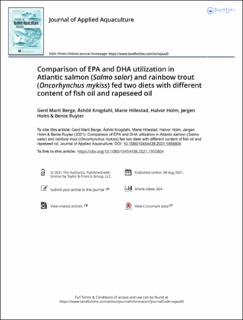| dc.contributor.author | Berge, Gerd Marit | |
| dc.contributor.author | Krogdahl, Åshild | |
| dc.contributor.author | Hillestad, Marie | |
| dc.contributor.author | Holm, Halvor | |
| dc.contributor.author | Holm, Jørgen | |
| dc.contributor.author | Ruyter, Bente | |
| dc.date.accessioned | 2021-10-05T08:44:36Z | |
| dc.date.available | 2021-10-05T08:44:36Z | |
| dc.date.created | 2021-10-04T10:21:51Z | |
| dc.date.issued | 2021 | |
| dc.identifier.citation | Journal of Applied Aquaculture. 2021, . | |
| dc.identifier.issn | 1045-4438 | |
| dc.identifier.uri | https://hdl.handle.net/11250/2787635 | |
| dc.description.abstract | Atlantic salmon and rainbow trout with initial weights of 460–468 g were fed two diets either high in fish oil (FO) or rapeseed oil (RO) content. The abilities of the fish to metabolize and deposit lipid and n-3 fatty acids were compared. Growth rates, FCR, and fat digestibility were similar in both species. Rainbow trout showed higher condition factors and lower dress-out percentage and hepatosomatic index than salmon. Whole-body content of EPA and DHA were higher in both species fed the FO diet than in the RO diet, but indicated higher capacities to produce DHA in rainbow trout than in salmon. The total fat content in the RO group was lower and DHA higher in rainbow trout liver than in salmon, indicating a greater ability of rainbow trout to increase metabolism to DHA. | |
| dc.language.iso | eng | |
| dc.title | Comparison of EPA and DHA utilization in Atlantic salmon (Salmo salar) and rainbow trout (Oncorhynchus mykiss) fed two diets with different content of fish oil and rapeseed oil | |
| dc.type | Peer reviewed | |
| dc.type | Journal article | |
| dc.description.version | publishedVersion | |
| dc.source.pagenumber | 19 | |
| dc.source.journal | Journal of Applied Aquaculture | |
| dc.identifier.doi | 10.1080/10454438.2021.1955804 | |
| dc.identifier.cristin | 1942915 | |
| cristin.ispublished | true | |
| cristin.fulltext | original | |
| cristin.qualitycode | 1 | |
